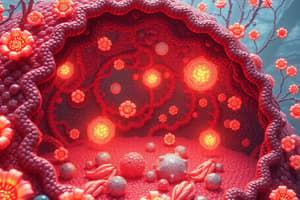Podcast
Questions and Answers
Las proteínas de la membrana celular que participan en el transporte activo incluyen ATPasas, importadores, exportadores, translocadores y receptores.
Las proteínas de la membrana celular que participan en el transporte activo incluyen ATPasas, importadores, exportadores, translocadores y receptores.
False (B)
El transporte activo mueve sustancias a favor de su tendencia natural de difusión, desde áreas de mayor concentración a áreas de menor concentración.
El transporte activo mueve sustancias a favor de su tendencia natural de difusión, desde áreas de mayor concentración a áreas de menor concentración.
False (B)
El transporte activo depende principalmente de dos tipos de proteínas de transporte: ATPasas y transportadores de glucosa.
El transporte activo depende principalmente de dos tipos de proteínas de transporte: ATPasas y transportadores de glucosa.
False (B)
El transporte mediado por canales permite el movimiento selectivo de solutos individuales basado en tamaño y carga.
El transporte mediado por canales permite el movimiento selectivo de solutos individuales basado en tamaño y carga.
El transporte vesicular implica la formación de canales para el movimiento de moléculas a través de la membrana celular.
El transporte vesicular implica la formación de canales para el movimiento de moléculas a través de la membrana celular.
La difusión facilitada es un tipo de transporte activo que requiere energía para mover solutos a través de la membrana celular.
La difusión facilitada es un tipo de transporte activo que requiere energía para mover solutos a través de la membrana celular.
La simple difusión implica el movimiento de partículas desde un área de baja concentración hacia un área de alta concentración.
La simple difusión implica el movimiento de partículas desde un área de baja concentración hacia un área de alta concentración.
Los lípidos no polares dentro de la bicapa lipídica participan en la difusión simple al no presentar una barrera significativa para el paso de solutos pequeños.
Los lípidos no polares dentro de la bicapa lipídica participan en la difusión simple al no presentar una barrera significativa para el paso de solutos pequeños.
Las proteínas de membrana son cruciales para los mecanismos de transporte de membrana y participan únicamente en la difusión simple.
Las proteínas de membrana son cruciales para los mecanismos de transporte de membrana y participan únicamente en la difusión simple.
El transporte activo implica el movimiento de solutos a través de la membrana celular sin requerir energía adicional.
El transporte activo implica el movimiento de solutos a través de la membrana celular sin requerir energía adicional.
Flashcards are hidden until you start studying
Study Notes
Membrane transport mechanisms play a crucial role in maintaining intracellular homeostasis, allowing cells to communicate with their environment and survive. They can be categorized into passive and active processes. In this article, we will discuss various membrane transport systems, including facilitated diffusion, simple diffusion, membrane proteins involved, active transport, and membrane transport mechanisms.
Facilitated Diffusion
Facilitated diffusion is a type of passive transport that involves the participation of specific proteins called carrier molecules or channels. These proteins enable the movement of solutes across the cell membrane down their concentration gradient without requiring energy input. This process allows the cell to maintain its ionic balance during metabolism, especially when there is a change in pH due to metabolic activities.
Simple Diffusion
Simple diffusion is another form of passive transport where particles move from an area of high concentration to low concentration by pure chance. It occurs through non-polar lipids within the phospholipid bilayer, which does not have any significant barrier to solute passage if they are small enough. Examples of simple diffusion particles are O₂, CO₂, N₂, H₂O, CO, and other volatile materials.
Membrane Proteins Involved
Membrane transport mechanisms involve membrane proteins, which are integral to the functioning of these processes. There are several types of membrane proteins involved in active transport, such as ATPases, importers, exporters, translocators, and receptors. Some examples of these proteins include ABC transporters, NAD(P)H-quinone oxidoreductase (NQO), cytochrome and bacteriorhodopsin, and voltage gated channels.
Active Transport
Active transport is a form of cellular transport that requires energy consumption. It moves substances against their natural tendency to diffuse from areas of higher concentration to areas of lower concentration. This process relies primarily on two main types of transport proteins: primary active transport proteins (e.g., ATPases) and secondary active transport proteins. Active transport is essential for maintaining high ion concentrations inside cells and is regulated by enzymes like Na⁺/K⁺ pump.
Membrane Transport Mechanisms
Membrane transport mechanisms employ a variety of strategies to facilitate solute movement across biological membranes, including both passive and active processes. Some common methods include:
- Channel transport: Channels allow the selective movement of individual solutes based on size and charge.
- Carrier-mediated transport: Carriers bind substrates and release them on the opposite side of the membrane after conformational changes.
- Vesicular transport: Vesicles move between different compartments, carrying cargo and dissolving into target membranes.
In summary, membrane transport mechanisms play a vital role in maintaining cellular integrity and supporting life-sustaining functions. Understanding these processes helps us appreciate the complexity of intracellular communication and the need for precise regulation to ensure proper functioning of organelles and cellular processes.
Studying That Suits You
Use AI to generate personalized quizzes and flashcards to suit your learning preferences.



